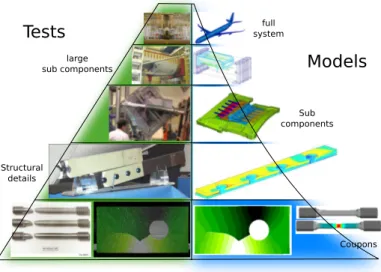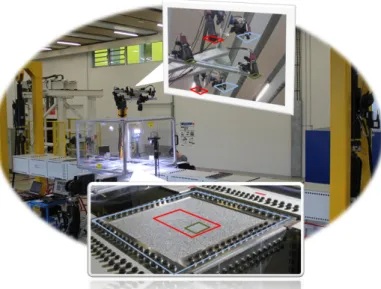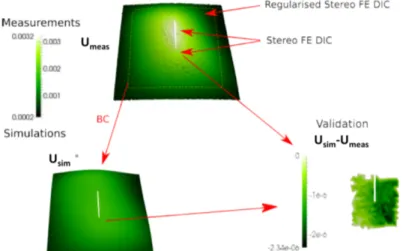HAL Id: hal-01882758
https://hal.archives-ouvertes.fr/hal-01882758
Submitted on 8 Feb 2019
HAL is a multi-disciplinary open access
archive for the deposit and dissemination of
sci-entific research documents, whether they are
pub-lished or not. The documents may come from
teaching and research institutions in France or
abroad, or from public or private research centers.
L’archive ouverte pluridisciplinaire HAL, est
destinée au dépôt et à la diffusion de documents
scientifiques de niveau recherche, publiés ou non,
émanant des établissements d’enseignement et de
recherche français ou étrangers, des laboratoires
publics ou privés.
FE DIC for strengthening the experiment/simulation
dialog: application to composites
Jean-Noël Périé, Jean-Charles Passieux
To cite this version:
Jean-Noël Périé, Jean-Charles Passieux. FE DIC for strengthening the experiment/simulation dialog:
application to composites. 8th International Conference on Structural Analysis of Advanced Materials
(ICSAAM 18), Aug 2018, Tarbes, France. �hal-01882758�
FE DIC for strengthening the experiment/simulation
dialog: application to composites
Jean-No ¨el P ´eri ´e
1and Jean-Charles Passieux
11Universit ´e de Toulouse – Institut Cl ´ement Ader (CNRS UMR 5312) – INSA/UPS/Mines Albi/ISAE 3, rue Caroline Aigle F-31400 Toulouse,
France
Abstract
D
igital Image Correlation (DIC) nowadays appears as a very convenient counterpart to FE sim-ulation for validation or identification purposes. Nevertheless, DIC strain resolution is high compared to the strains met in composite structures, and classical subset based DIC are not convenient to couple with finite element (FE) simulations. With the emergence of FE-Stéréo DIC (FE-SDIC) approaches, and the use of multiscale measurements, it now becomes possible to make objective and quantitative comparisons between computed and measured displacements. In addition, FE-SDIC also makes it possible to regularize the measurements using part of the model. This makes it easier to assess mechanically consistent boundary conditions. The example of the experiment/simulation dialog proposed structural test perfomed during the ANR VERTEX project is presented.Keywords: Digital Image Correlation, Finite Element, Structural Test, Composites
1
Limitations of subset based DIC
Because of their multiscale architecture and the manufacturing process, composite structures exhibit very com-plex mechanical behaviors that are not all well understood and that are hard to incorporate into models. As a
Tests
Models
Coupons Structural details large sub components full system Sub componentsFE DIC for strengthening the experiment/simulation dialog: application to composites
Figure 2: Vertex bench and its associated instrumentation
consequence, the certification of aerostructures still rely on the so called test pyramid (cf. Figure 1). In practice, the identification of the constitutive parameters usually rely on experiments performed at the lowest level of the test pyramid, and particularly at the coupon scale. In this case, standard testing and instrumentation (eg gages, extensometers) are resorted to study simple specimens that may not be very representative of the material present in the actual structures. The validation of the modeling is then achieved at higher levels, for instance on sub structures. Very specific specimens and experiments are then used and, up to now, quantitative compaisons between measured and computed strains are only based on a classical instrumentation.
Kinematic full-field measurements now allow to take a new insight at the mechanics of such structures. Due to its simplicity of use, its wide range of applications (shape and displacement measurements, large deformations, dynamics, etc.) and its unique ability to exploit different imaging modalities (microscopy, tomography, etc.), Digital Image Correlation (DIC) has become the reference full field measurement method. It has been widely used for validating FE simulations, although the comparisons often remain qualitative. The technique has even been used for identification purposes [1]. In this context, it seems appealing to exploit experiments performed on demonstrators (simpler to produce/reproduce than sub-structures, but still more representative than coupons) in situations more representative of their use (structural tests, multiaxial tests, etc.) to identify constitutive parameters.
The subset-based approach initiated in the 1980s remains the most common DIC technique. This approach is easy to handle and use, but it exibits several limitations. For example, even if he has a very low number of parameters to tune, the user has always to face a difficult compromise between spatial resolution and measurement resolution. By the way, the achievable strain resolution is limited in comparison with the strain observed in composite structures. In addition, this approach to DIC does not make interfacing DIC measurements and FE models easy. For instance, the strain spatial resolutions of both techniques are usually not comparable, the coordinate systems are different and no DIC information can be retrieved on the edges. Finally, such an approach can not take advantage of any relevant mechanical information.
2
FE-SDIC and structural testing
In the course of the 2000s, new formulations of the DIC (so-called global) were proposed. The displacement field is then interpolated in the whole Region Of Interest (instead than in subsets). Global DIC makes it possible to integrate a more or less important a priori, in particular on the mechanical behaviour. For example, the FE-DIC makes it possible to use a Finite Element description of the displacement field [2]. It is therefore possible, in theory, to exploit the optimized FE mesh built for simulation purposes. This provides the opportunity to avoid reprojection issues when comparing simulations and experiments [3], to integrate the model into the measurement in order to regularize it, or even to identify constitutive parameters directly from images (Integrated DIC).
FE DIC for strengthening the experiment/simulation dialog: application to composites
Figure 3: Experiment/simulation dialog established by using a FE approach to stereo DIC
of structural testing. For instance, the interest of a "multi-scale" instrumentation in the context of identification [3] will be demonstrated in a simple 2D case. A far field view allows estimating boundary conditions, while the addition of a near field view allows reducing drastically the measurement uncertainties for a given simulation mesh. The case of structural tests performed during the ANR VERTEX project will then specifically be detailed [4]. A large notched laminate panel is subjected to a complex biaxial loading thanks to a specific bench (cf. Figure 2). An original FE-SDIC method has been developped to treat such a 3D case [5]. A part of the specimen, outside of the damaged region, is assumed to remain elastic and is considerd as a test specimen ("load cell"). By using far field images, a regularised FE-SDIC gives access to mechanically consistent boudary conditions (cf. Figure 3) for the simulation. In the same time, near field images allow retrieving well resolved displacements while using the "fine" simulation mesh near the notch-tips (cf. Figure 3).
References
[1] L. Crouzeix, J. N. Périé, F. Collombet, B. Douchin, An orthotropic variant of the equilibrium gap method applied to the analysis of a biaxial test on a composite material. Composites Part A: Applied Science and Manufacturing,
40(11), 1732-1740, 2009.
[2] G. Besnard, F. Hild, S. Roux, "Finite-element" displacement fields analysis from digital images: Application to Portevin-Le Chatelier bands. Experimental Mechanics.46(6):789-804, 2006
[3] J.-C. Passieux, F. Bugarin, C. David, J.-N. Périé, L. Robert, Multiscale displacement field measurement using digital image correlation: Application to the identification of elastic properties. Experimental Mechanics.55(1)121-137,
2015
[4] J. Serra, J. E. Pierré, J. C. Passieux, J. N. Périé, C. Bouvet, B. Castanié, Validation and modeling of aeronautical composite structures subjected to combined loadings: The VERTEX project. Part 1: Experimental setup, FE-DIC instrumentation and procedures. Composite Structures,179:224-244, 2017
[5] J.-E. Pierré, J.-C. Passieux, J.-N. Périé, Finite Element Stereo Digital Image Correlation: framework and mechanical regularization. Experimental Mechanics.53(7):443-456, 2017


